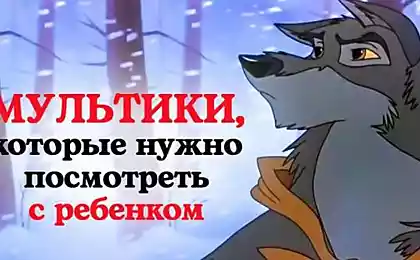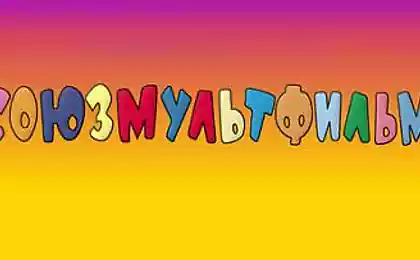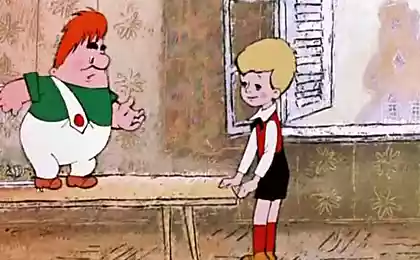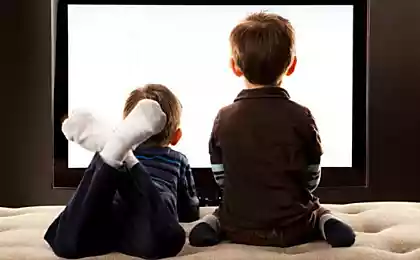700
"Mowgli" the United States and the Soviet Union: What kind of ideology educates children through cartoons
Recently watched the Soviet cartoon “Mowgli” – honestly, just sucked. Drew attention to a number of important points, which can be called "programming of values". Was curious and found the American equivalent of "Mowgli". It's amazing how different these paintings! And how different people they bring!
The INDIVIDUALS
In the Soviet version (SV) all the characters are charismatic and possess a personal charisma, a unique dynamic way, while in amerikosskoy version (AV) all the characters are the same – equally moving, equally telling, devoid of any charisma and look like clowns.
Due to this, in SV have a clear idea of implement it to their strengths.
Twenty two million six hundred seventy one thousand seventy four
SV – generally very deep and emotionally powerful cartoon. Here clearly refers to friendship, mutual support, and each team plays on their strong side: Kaa – is not engaged in the fight, but he is wise and strategic decisions (to find the blade, to defeat the red dogs); Bagira – just the ideal of femininity, I would add – the alpha female: she is strong and dangerous and graceful and gentle, playful and spontaneous, but at the same time witty and wise (she is the “razrulil” theme with the rescue Mowgli, giving the crowd a bull to the pack meeting); Balu is a great teacher; Akella is a wise and fair leader; the Wolf-mother is ready to give their lives for a foster child; Sherkhan – strong, ferocious and cunning, he is not playing by the rules and in the end gets his just desserts for it; the Jackal full of fear, and perhaps the most vile character in the cartoon. All the characters are Mature, charismatic and clearly see your place in the jungle.
In AV – anything like that just yet. All the characters are equally stupid and funny. Despite the different plastics that all have the same faces and emotions. The concept of its journey upside down – monkey wants to become a man, the elephants go system, and Mowgli could not decide whom he was to be, someone to emulate. And Bagheera, in General, man!
Twenty nine million seven hundred thirty nine thousand one hundred eighteen
THE ATMOSPHERE AND CONCEPT
In the ne, of course, it's not so... colorful and harmonious. The harsh Soviet realism is, perhaps, minus. But this on its own is symbolic because makes it easier to mentally step back and see the essence of the cartoon:
In the American cartoon all “lupasit” and “stebut” each other, it's like “fun”: a General concept (idea) of the cartoon is just entertaining. The atmosphere of contention, there is no consensus, egoism, everyone acts in their own interests.
Idea: sing and dance to “curb their own needs” – and everything will be fine.
At first glance, is also a good message, a positive like this, but it really smacks of propaganda to entertainment, not creative work.
The theme of friendship is also present in AV. However, where each character wants to get something from Mowgli or to impose their point of view. The battle with the tiger at the end is also fun and simple. And Mowgli behaves there is very peculiar, but more on that later.
AND NOW THE MOST IMPORTANT CHARACTER AND HIS RELATIONSHIP
At Holy Mowgli, developed over several episodes. It reveals their strengths, more aware of who he is. He becomes stronger, smarter, faster. He becomes the leader of the pack, and wins the invasion, and gets the dagger, and he defeats a tiger with his bare hands.
First, he learns as a child, but it soon becomes independent, he takes decisions, he is active, enterprising and savvy. He behaves bravely and held with dignity.
In AVI Mowgli – the consumer. He's cranky and lonely. He can't find his place in life. It tries to be a bear, the elephant, the vulture. Morality as a fact – whether a person, whom you are supposed to be, but the General emotional background that creates the sensation of searching and even despair, creating a conflict. And how is it solved? In the end Mowgli not he decides to go to the people, and “being” in years “sexy girl”…
The whole cartoon to guide him, care about him, govern him: a feeling that the choice of Mowgli is that, to who would join whom to trust yourself. Mowgli himself does not solve anything, always decide for him from the very beginning to the very end. I.e. it is set to the image of the slave user, and not an independent being.
In ST. Mowgli sincerely friends with the characters, helps them, and together they solve some of the problem. If fooling around, somehow very kind. All the positive characters get along with each other and work in a team, set specific goals and achieve them.
In AV the characters quarrel among themselves, divide the Mowgli like he has no choice (and it really is just not), and everyone wants to satisfy his ego through it. Cowardly characters like Mowgli. And all the characters are neurotic, hysterical and overly emotional – they have no essence, core, they often change their decisions, inconsistent, in short quite chaotic and lost.
Mowgli in ST respect for his brothers, protect them, heed their wisdom, they support each other and work together. In AV Mowgli forever alone repels other characters; the conflict is based on the fact that you can't trust anyone.
THE FINAL SCENE
In ST. Mowgli has grown and evolved from a fun full of energy boy-frog to handsome man, decent, strong, experienced. The climax of his maturity is his epic and pretty brutal victory over Sher Khan. Mowgli's brothers comes up with a plan and implements it, fights with Sher Khan one on one, and even lost the blade in battle, wins a narrow victory – with his bare hands. The final victory, as evidenced by the skin on the stone. Then Mowgli falls in love and realises that he can't live forever in the jungle. Then he decides to leave, to leave “his high office” for the sake of new life. The pack says goodbye to him and accepts his choice, finally saying that if you need anything – we are always with you.
Notable scene Mowgli with a girl. First, they are already “adults”. The girl, seeing luxury Mowgli drops the jar and runs away, turning around again and again. She's scared of him and shows interest. He, too, Mowgli runs away and cries on his chest from the Ball, because it awakened a sense of love, and he realizes that it's time to go to the people.
I.e. achieving the maximum in the jungle, the leader of the pack, the Grand prize winner of a very cunning enemy, is sent for love to new heights. I'm sure there he will succeed.
That's the story of progress and a bold move forward. Last frame – the adult, strong willed Mowgli says goodbye to his brothers in the background of the village, moving to a new life.
Now let's see what happens in the AV:
Mowgli was a thin boy and still is – he never grew up, did not evolve. He's a kid, just a kid is a cranky, confused, incredulous and lonely. He looks for who else to join – after all, “past friends” was cheating on him…
Here he meets the vultures, and IT is Sher Khan. New friends cowardly run away, but Mowgli is not lost, and as if not afraid of a fight. Sherkhan as a typical American eats the villain from the hero, and decides to talk to him and play. Typical error of the villain.
At this moment there is the Ball and rushes into the fray, the Mowgli runs away but then finds a stick and beats the tiger while he is immobilized, however, when tiger is released, Mowgli runs away screaming “help.” Then all of a sudden lightning strikes a tree while Sherkhan distract the vultures, Mowgli ties his tail to a stick, and Sher Khan cowardly runs away …
The ball, as if dying: the maudlin scene where the bear listens to post-mortem it sweetly and gets in the face of it(!) when everyone will know that Baloo is alive. Then they go into the jungle. But Mowgli saw a girl and decided to consider it. Balu says: “do Not go there all the problems” (installation on another floor). However, Mowgli is not childish, being, girl hypnotizes his beautiful eyes, and Mowgli in the end, AS IN a TRANCE comes over her. The girl drops her pitcher, to Mowgli told him, and he again is and carries. Baloo yells: “Forget it, let's go to the jungle.” but Mowgli shakes his shoulders and goes, besotted with the girl.
The characters sing the song, how cool to live in the jungle, the end.
A couple of comments. In SV basic plans are the people, and absolutely not in the frame of “soft spots”. While in AV it is this part of the body plays an important role, constantly figuring in the foreground. In the ne I didn't notice frankly stupid characters. In AV – all the characters are stupid. Remarkable is also the scene with the elephants – one behaves like a zombie and constantly eats; in another scene – back in the third – hysterical wife yelling at arrogant husband.
TOTAL
Soviet cartoon fosters strong, brave, courageous, savvy, independent person who has goals and reaches them. Uses the power of the collective. Takes into account the strengths of allies and enemies, and acts safely and effectively. An example of relations – strong, confident leader-a man capable of deep passionate feelings. The role of a boy to become a man.
American cartoon educates slave. Moody distrustful of the consumer, prone to neuroses and loneliness, untrusting and deceived. Which is always guided by someone. Who does not know his strengths, not making plans, not making decisions. For it always decide his conduct. In the end it turns out that he is not the main character, and the main characters is carefree bear and Bagheera-the man who ruled the roost in the jungle.
And, by the way, with regards to humor. Humor allows us not to perceive the information critically and to expand the scope of what is permitted: it's a joke, that's fine. So give the installation and the images very well through humor.
When a child is watching a cartoon, he has very little of his experience to decide what is normal and what is not. When he sees that in the cartoon the characters behave in any way, and no one condemns the child adopts this behavior as normal. And he models in his life what he sees. A kid watching Soviet cartoon, will think that courage and honor – it's okay to set goals and achieve them – it's OK to fight and win – this is normal. To be the Creator and author of their own destiny is normal.
A child watching an American cartoon, will think that when you run – it's okay, betrayal, and loneliness is normal, and neurotic moodiness is normal. To be a consumer – this is normal.
Now think about what you see yourself and your kids (yours, nephews, brothers and sisters). What images do they see? What behaviors will be normal? What they will bring to your life? And that you yourself embody?
This is education, this is EDUCATION. Today, they watch disney cartoons, tomorrow listen to pop music, and the next day their ideals and values are becoming selfish and consumer color peculiar to Western culture. More serious than it seems. Ignoring the problem, we do not walk away from it, and just pass the power to those who she is not refusing, that's all. Using information – movies, cartoons, music, programs, games and so on – is the imposition of a welcome to someone behaviors. This particularly affects children.
So beware. Create light, strong, brave, honest. Filter information flows for themselves and especially for their children.
Author: Daniel Sargan
P. S. And remember, just changing your mind — together we change the world! ©
Join us in Facebook , Vkontakte, Odnoklassniki
Source: d-b.livejournal.com/523903.html
The INDIVIDUALS
In the Soviet version (SV) all the characters are charismatic and possess a personal charisma, a unique dynamic way, while in amerikosskoy version (AV) all the characters are the same – equally moving, equally telling, devoid of any charisma and look like clowns.
Due to this, in SV have a clear idea of implement it to their strengths.
Twenty two million six hundred seventy one thousand seventy four
SV – generally very deep and emotionally powerful cartoon. Here clearly refers to friendship, mutual support, and each team plays on their strong side: Kaa – is not engaged in the fight, but he is wise and strategic decisions (to find the blade, to defeat the red dogs); Bagira – just the ideal of femininity, I would add – the alpha female: she is strong and dangerous and graceful and gentle, playful and spontaneous, but at the same time witty and wise (she is the “razrulil” theme with the rescue Mowgli, giving the crowd a bull to the pack meeting); Balu is a great teacher; Akella is a wise and fair leader; the Wolf-mother is ready to give their lives for a foster child; Sherkhan – strong, ferocious and cunning, he is not playing by the rules and in the end gets his just desserts for it; the Jackal full of fear, and perhaps the most vile character in the cartoon. All the characters are Mature, charismatic and clearly see your place in the jungle.
In AV – anything like that just yet. All the characters are equally stupid and funny. Despite the different plastics that all have the same faces and emotions. The concept of its journey upside down – monkey wants to become a man, the elephants go system, and Mowgli could not decide whom he was to be, someone to emulate. And Bagheera, in General, man!
Twenty nine million seven hundred thirty nine thousand one hundred eighteen
THE ATMOSPHERE AND CONCEPT
In the ne, of course, it's not so... colorful and harmonious. The harsh Soviet realism is, perhaps, minus. But this on its own is symbolic because makes it easier to mentally step back and see the essence of the cartoon:
- Look for their strengths and find their place in society. The power of friendship, the team, the famous “we're the same blood”, cooperation in solving the problem.
- Together you can achieve much more than alone. The team is important and useful. Again, respect for the individual. Everyone does what he does best.
- Good eventually triumphs over evil. Cartoon teaches us to be honest and strong and play on the light side. For darkness is defeated. Often the characters were going to die and was ready to fight to the end for what they love, and fate rewarded them for bravery – the situation was resolved either peacefully (as in the Council), or in their favor (as at the end of the cartoon).
- Bravery and honor are awarded. Dishonor, deceit and cowardice is punished.
- All work: porcupines roll pumpkins, wolves hunt and learn(!) bear teaches, a leader leads, and so on. Conclusion: work – and get results.
In the American cartoon all “lupasit” and “stebut” each other, it's like “fun”: a General concept (idea) of the cartoon is just entertaining. The atmosphere of contention, there is no consensus, egoism, everyone acts in their own interests.
Idea: sing and dance to “curb their own needs” – and everything will be fine.
At first glance, is also a good message, a positive like this, but it really smacks of propaganda to entertainment, not creative work.
The theme of friendship is also present in AV. However, where each character wants to get something from Mowgli or to impose their point of view. The battle with the tiger at the end is also fun and simple. And Mowgli behaves there is very peculiar, but more on that later.
AND NOW THE MOST IMPORTANT CHARACTER AND HIS RELATIONSHIP
At Holy Mowgli, developed over several episodes. It reveals their strengths, more aware of who he is. He becomes stronger, smarter, faster. He becomes the leader of the pack, and wins the invasion, and gets the dagger, and he defeats a tiger with his bare hands.
First, he learns as a child, but it soon becomes independent, he takes decisions, he is active, enterprising and savvy. He behaves bravely and held with dignity.
In AVI Mowgli – the consumer. He's cranky and lonely. He can't find his place in life. It tries to be a bear, the elephant, the vulture. Morality as a fact – whether a person, whom you are supposed to be, but the General emotional background that creates the sensation of searching and even despair, creating a conflict. And how is it solved? In the end Mowgli not he decides to go to the people, and “being” in years “sexy girl”…
The whole cartoon to guide him, care about him, govern him: a feeling that the choice of Mowgli is that, to who would join whom to trust yourself. Mowgli himself does not solve anything, always decide for him from the very beginning to the very end. I.e. it is set to the image of the slave user, and not an independent being.
In ST. Mowgli sincerely friends with the characters, helps them, and together they solve some of the problem. If fooling around, somehow very kind. All the positive characters get along with each other and work in a team, set specific goals and achieve them.
In AV the characters quarrel among themselves, divide the Mowgli like he has no choice (and it really is just not), and everyone wants to satisfy his ego through it. Cowardly characters like Mowgli. And all the characters are neurotic, hysterical and overly emotional – they have no essence, core, they often change their decisions, inconsistent, in short quite chaotic and lost.
Mowgli in ST respect for his brothers, protect them, heed their wisdom, they support each other and work together. In AV Mowgli forever alone repels other characters; the conflict is based on the fact that you can't trust anyone.
THE FINAL SCENE
In ST. Mowgli has grown and evolved from a fun full of energy boy-frog to handsome man, decent, strong, experienced. The climax of his maturity is his epic and pretty brutal victory over Sher Khan. Mowgli's brothers comes up with a plan and implements it, fights with Sher Khan one on one, and even lost the blade in battle, wins a narrow victory – with his bare hands. The final victory, as evidenced by the skin on the stone. Then Mowgli falls in love and realises that he can't live forever in the jungle. Then he decides to leave, to leave “his high office” for the sake of new life. The pack says goodbye to him and accepts his choice, finally saying that if you need anything – we are always with you.
Notable scene Mowgli with a girl. First, they are already “adults”. The girl, seeing luxury Mowgli drops the jar and runs away, turning around again and again. She's scared of him and shows interest. He, too, Mowgli runs away and cries on his chest from the Ball, because it awakened a sense of love, and he realizes that it's time to go to the people.
I.e. achieving the maximum in the jungle, the leader of the pack, the Grand prize winner of a very cunning enemy, is sent for love to new heights. I'm sure there he will succeed.
That's the story of progress and a bold move forward. Last frame – the adult, strong willed Mowgli says goodbye to his brothers in the background of the village, moving to a new life.
Now let's see what happens in the AV:
Mowgli was a thin boy and still is – he never grew up, did not evolve. He's a kid, just a kid is a cranky, confused, incredulous and lonely. He looks for who else to join – after all, “past friends” was cheating on him…
Here he meets the vultures, and IT is Sher Khan. New friends cowardly run away, but Mowgli is not lost, and as if not afraid of a fight. Sherkhan as a typical American eats the villain from the hero, and decides to talk to him and play. Typical error of the villain.
At this moment there is the Ball and rushes into the fray, the Mowgli runs away but then finds a stick and beats the tiger while he is immobilized, however, when tiger is released, Mowgli runs away screaming “help.” Then all of a sudden lightning strikes a tree while Sherkhan distract the vultures, Mowgli ties his tail to a stick, and Sher Khan cowardly runs away …
The ball, as if dying: the maudlin scene where the bear listens to post-mortem it sweetly and gets in the face of it(!) when everyone will know that Baloo is alive. Then they go into the jungle. But Mowgli saw a girl and decided to consider it. Balu says: “do Not go there all the problems” (installation on another floor). However, Mowgli is not childish, being, girl hypnotizes his beautiful eyes, and Mowgli in the end, AS IN a TRANCE comes over her. The girl drops her pitcher, to Mowgli told him, and he again is and carries. Baloo yells: “Forget it, let's go to the jungle.” but Mowgli shakes his shoulders and goes, besotted with the girl.
The characters sing the song, how cool to live in the jungle, the end.
A couple of comments. In SV basic plans are the people, and absolutely not in the frame of “soft spots”. While in AV it is this part of the body plays an important role, constantly figuring in the foreground. In the ne I didn't notice frankly stupid characters. In AV – all the characters are stupid. Remarkable is also the scene with the elephants – one behaves like a zombie and constantly eats; in another scene – back in the third – hysterical wife yelling at arrogant husband.
TOTAL
Soviet cartoon fosters strong, brave, courageous, savvy, independent person who has goals and reaches them. Uses the power of the collective. Takes into account the strengths of allies and enemies, and acts safely and effectively. An example of relations – strong, confident leader-a man capable of deep passionate feelings. The role of a boy to become a man.
American cartoon educates slave. Moody distrustful of the consumer, prone to neuroses and loneliness, untrusting and deceived. Which is always guided by someone. Who does not know his strengths, not making plans, not making decisions. For it always decide his conduct. In the end it turns out that he is not the main character, and the main characters is carefree bear and Bagheera-the man who ruled the roost in the jungle.
And, by the way, with regards to humor. Humor allows us not to perceive the information critically and to expand the scope of what is permitted: it's a joke, that's fine. So give the installation and the images very well through humor.
When a child is watching a cartoon, he has very little of his experience to decide what is normal and what is not. When he sees that in the cartoon the characters behave in any way, and no one condemns the child adopts this behavior as normal. And he models in his life what he sees. A kid watching Soviet cartoon, will think that courage and honor – it's okay to set goals and achieve them – it's OK to fight and win – this is normal. To be the Creator and author of their own destiny is normal.
A child watching an American cartoon, will think that when you run – it's okay, betrayal, and loneliness is normal, and neurotic moodiness is normal. To be a consumer – this is normal.
Now think about what you see yourself and your kids (yours, nephews, brothers and sisters). What images do they see? What behaviors will be normal? What they will bring to your life? And that you yourself embody?
This is education, this is EDUCATION. Today, they watch disney cartoons, tomorrow listen to pop music, and the next day their ideals and values are becoming selfish and consumer color peculiar to Western culture. More serious than it seems. Ignoring the problem, we do not walk away from it, and just pass the power to those who she is not refusing, that's all. Using information – movies, cartoons, music, programs, games and so on – is the imposition of a welcome to someone behaviors. This particularly affects children.
So beware. Create light, strong, brave, honest. Filter information flows for themselves and especially for their children.
Author: Daniel Sargan
P. S. And remember, just changing your mind — together we change the world! ©
Join us in Facebook , Vkontakte, Odnoklassniki
Source: d-b.livejournal.com/523903.html
How to stop obsessing about the relationship and just enjoy it
How to get out of the woods without a map and compass if You get lost























